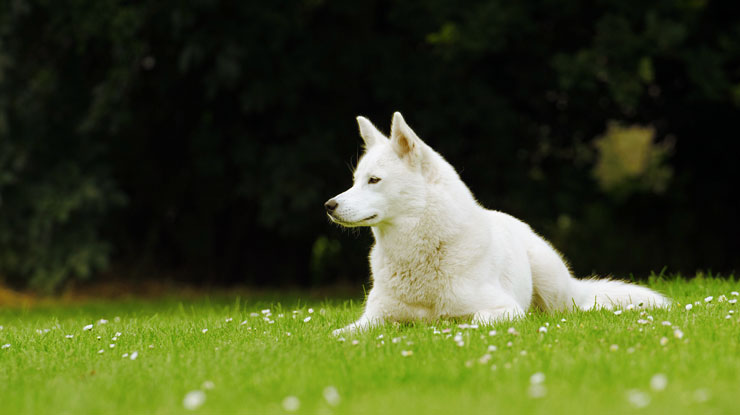
Is Your Dog Suffering from Seasonal Allergies?
It starts with an itch, but soon grows into a full-blown scratch attack. In humans, seasonal allergy symptoms typically develop in the respiratory tract and the sinuses, those telltale signs of sneezes, coughs, watery eyes, and runny noses.
Dogs also experience seasonal allergies, although their symptoms manifest differently than humans. A dog’s seasonal allergies surface as allergic dermatitis—skin irritation or inflammation—which can vary from mild to severe.
When the allergen (pollen, for example) touches the skin, the dog’s body responds at the skin’s surface with an itch or irritation. As the allergy intensifies over time, so does the itch. Dogs desperate for relief will scratch excessively. They may even bite, chew, or gnaw the itchy area on their bodies.
Rough surfaces (like furniture or freshly vacuumed carpet) offer the perfect rub for itchy faces and bodies. But too much scratching can turn irritated skin into a hot spot (an inflamed, infected area that may bleed or show hair loss). Inflammation of any kind can breed a host of health issues, so preventative and proactive treatments are best.
Although warmer months provide great outdoor fun, they also carry heavier allergen loads. It’s impossible to escape every outdoor allergen, but consistent allergy treatment can reduce a dog’s reactions. Flank seasonal allergies with two approaches: topical and internal.

Topical Tactics
If you suspect that your dog may be suffering from allergies, the best approach is to schedule an appointment with your veterinarian to figure out which steps to take next. The following remedies have been known to produce positive results in some dogs, but check with your vet before trying them out at home.
Cool-water soak. On warm afternoons, fill the tub with enough water to cover the paws. Add several cups of Epsom salt to dissolve in the water. Once the water is cool, let the dog stand in the water for 10 to 15 minutes.
Gently pat the paws dry with a towel. The water must be cool. Warm or hot water will aggravate itchy, irritated skin. Do not allow the dog to drink the salty water (which could act as a laxative). Instead, offer handfed treats during the soak.
Coconut oil conditioning. During regular baths, condition the dog’s coat with coconut oil, massaging the oil from head to tail. Coconut oil soothes irritated skin and has antibacterial properties.
Oatmeal poultices and baths. Aveeno colloidal oatmeal bath treatment easily mixes with water for a quick spot-specific poultice. Apply the poultice for about fifteen to twenty minutes and gently wash or wipe off with a damp cloth. For longer, full-body relief, add colloidal oatmeal to bath water. Occupy curious mouths with handfed treats while alternating (previously learned) sit, down, and stay commands.
White/apple cider vinegar ear cleaning. Some dogs may have an increased risk of ear infection due to allergies. If your vet has determined that your dog is suffering from yeast/fungal infection caused by allergies, ask for your veterinarian’s advice before cleaning your dog’s ear with vinegar.
Some dog owners have had success eliminating ear infections by pouring a very small amount of vinegar into the dog’s ear and gently massaging the ear (to distribute the vinegar, you’ll likely hear a splooshing sound). The acidic nature of vinegar should make it very difficult for fungi/yeasts to survive. After the vinegar has been distributed throughout the ear, you can clean up the remaining liquid with a cotton ball or pad.
Baking soda paste. For spot treatment, stir a small amount of baking soda and water (avoid runny or clumpy mixtures to prevent mess). Dab the itchy area with the paste, let dry for a few hours, and wash off.
Aloe vera. Apply aloe vera to irritated skin two to three times daily. Several bottled versions of the gel are available at stores, but the best source is the plant. Scrape the jelly from inside the leaves and use a fingertip to apply to the skin.
Vitamin E dab. Vitamin E is sold as a bottled liquid in many health stores. Find a company that commits to supplement purity (no additives or chemicals). Apply the ointment to irritated skin and hot spots as directed. Although the application may be messy, vitamin E soothes irritation and helps the body heal faster.

Supplement Support
As a reminder, always discuss dietary supplements with a veterinarian before giving them to your dog. If allergies persist, despite topical treatments and supplementation, contact your veterinarian.
Quercetin. A bioflavonoid found in many fruits and vegetables (such as kale and apples), quercetin is nicknamed “nature’s antihistamine.”
Omega-3 fatty acids. Fatty acids decrease inflammation in the body. Food sources include flaxseed oil, borage oil, and coconut oil. Dogs can take between one teaspoon and one tablespoon of flaxseed oil each day, depending on tolerance, size, and veterinarian approval.
Coconut oil. A great source of omega-3 fatty acids, coconut oil improves thyroid function and suppresses inflammatory responses within the body.
Vitamins C and E. C and E work together to help heal the body and boost the immune system, which helps the body self-manage against allergens.
Thyroid check. This isn’t supplement advice per se, but it can certainly be helpful nonetheless. An underactive thyroid may increase the body’s allergic response to allergens. Veterinarians can perform a yearly blood test to check a dog’s thyroid levels.
Steroid warning! Do not use steroids unless absolutely necessary. Steroids affect the adrenal glands (which may also affect the thyroid) and suppress the body’s natural immune response. Repeated suppression may cause greater harm than help.











